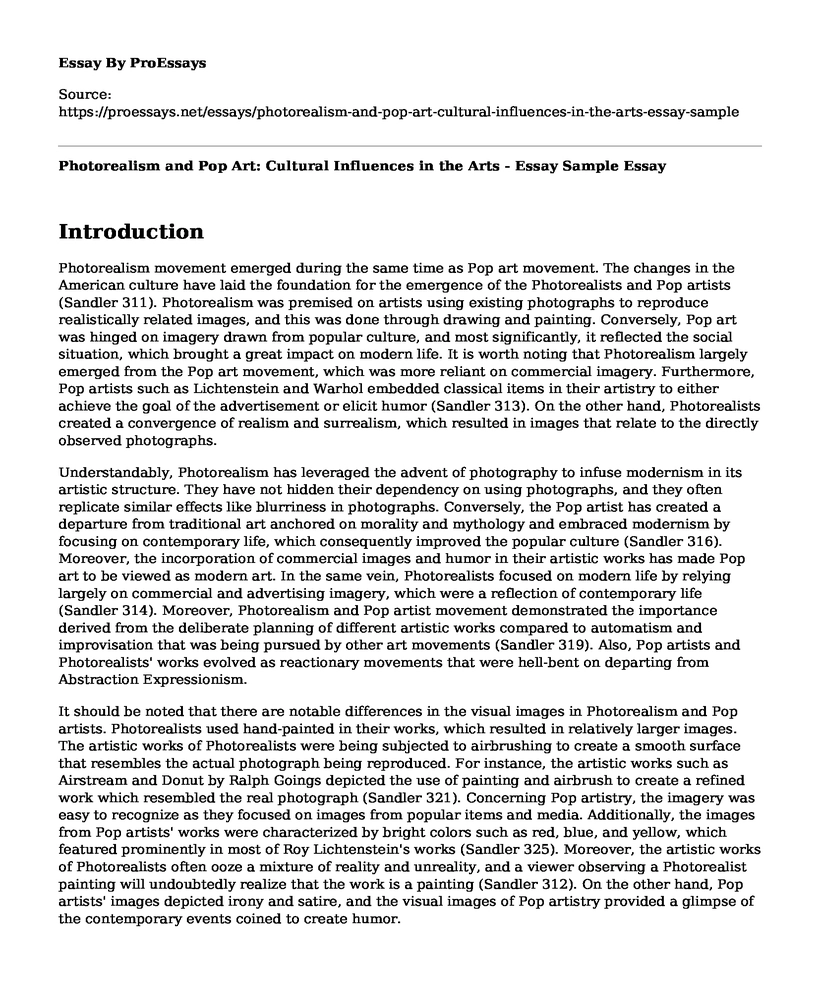Introduction
Photorealism movement emerged during the same time as Pop art movement. The changes in the American culture have laid the foundation for the emergence of the Photorealists and Pop artists (Sandler 311). Photorealism was premised on artists using existing photographs to reproduce realistically related images, and this was done through drawing and painting. Conversely, Pop art was hinged on imagery drawn from popular culture, and most significantly, it reflected the social situation, which brought a great impact on modern life. It is worth noting that Photorealism largely emerged from the Pop art movement, which was more reliant on commercial imagery. Furthermore, Pop artists such as Lichtenstein and Warhol embedded classical items in their artistry to either achieve the goal of the advertisement or elicit humor (Sandler 313). On the other hand, Photorealists created a convergence of realism and surrealism, which resulted in images that relate to the directly observed photographs.
Understandably, Photorealism has leveraged the advent of photography to infuse modernism in its artistic structure. They have not hidden their dependency on using photographs, and they often replicate similar effects like blurriness in photographs. Conversely, the Pop artist has created a departure from traditional art anchored on morality and mythology and embraced modernism by focusing on contemporary life, which consequently improved the popular culture (Sandler 316). Moreover, the incorporation of commercial images and humor in their artistic works has made Pop art to be viewed as modern art. In the same vein, Photorealists focused on modern life by relying largely on commercial and advertising imagery, which were a reflection of contemporary life (Sandler 314). Moreover, Photorealism and Pop artist movement demonstrated the importance derived from the deliberate planning of different artistic works compared to automatism and improvisation that was being pursued by other art movements (Sandler 319). Also, Pop artists and Photorealists' works evolved as reactionary movements that were hell-bent on departing from Abstraction Expressionism.
It should be noted that there are notable differences in the visual images in Photorealism and Pop artists. Photorealists used hand-painted in their works, which resulted in relatively larger images. The artistic works of Photorealists were being subjected to airbrushing to create a smooth surface that resembles the actual photograph being reproduced. For instance, the artistic works such as Airstream and Donut by Ralph Goings depicted the use of painting and airbrush to create a refined work which resembled the real photograph (Sandler 321). Concerning Pop artistry, the imagery was easy to recognize as they focused on images from popular items and media. Additionally, the images from Pop artists' works were characterized by bright colors such as red, blue, and yellow, which featured prominently in most of Roy Lichtenstein's works (Sandler 325). Moreover, the artistic works of Photorealists often ooze a mixture of reality and unreality, and a viewer observing a Photorealist painting will undoubtedly realize that the work is a painting (Sandler 312). On the other hand, Pop artists' images depicted irony and satire, and the visual images of Pop artistry provided a glimpse of the contemporary events coined to create humor.
The photorealism movement aims to embed modernity in art by focusing on collecting visual information derived from the modern-day photographs, which are primarily a departure from traditional artistry premised on observation (Sandler 323). Furthermore, Photorealists aim at creating artistic works that revolve on proper planning to result in better replication of the original photograph. Equally important, the Photorealism movement focused on creating a convergence of color and light to create quality work that would be embraced in modern life (Sandler 324). The key aim of Pop artistry was to use popular culture by incorporating advertising and commercial elements that relate to modernity. Moreover, the Pop art movement was focused on creating a departure from abstract expressionism by premising their works on mechanical reproduction.
Conclusion
In conclusion, Photorealism and Pop artist movement continues to play an integral role in modern artistry. The reproduction of images from real photographs through Photorealists' works has resulted in a convergence between reality and surrealism hence re-defining modern art. Furthermore, Pop artists and Photorealism have contributed significantly to the American social, economic, and cultural growth, notably because of the contemporary consumer society that has been created. More importantly, the incorporation of classical items by Pop artists has led to the achievement of the primary goal of bringing humor and furthering the advertisements and commercials which are synonymous with modern consumer society.
Work Cited
Sandler, Irving. Art of the Postmodern Era: from the late 1960s to the early 1990s. Routledge, 2018, pp. 311-325, https://www.taylorfrancis.com/books/9780429502194
Cite this page
Photorealism and Pop Art: Cultural Influences in the Arts - Essay Sample. (2023, Mar 09). Retrieved from https://proessays.net/essays/photorealism-and-pop-art-cultural-influences-in-the-arts-essay-sample
If you are the original author of this essay and no longer wish to have it published on the ProEssays website, please click below to request its removal:
- Marketing With Social Media: The Strong Student Event Paper Example
- Essay Sample on Architecture Work: Challenges & Billable Utilization
- How Women Are Treated and Looked at in "The Defiant Ones"
- Essay Sample on Cross-Channel Student Outreach: Social Media Strategy
- Selma Unveiled: Painting Depicts Civil Rights Struggle - Essay Sample
- John Donne's Contradictions Essay Example
- Research Paper on Talk Shows: Exploiting Victims for Entertainment?







